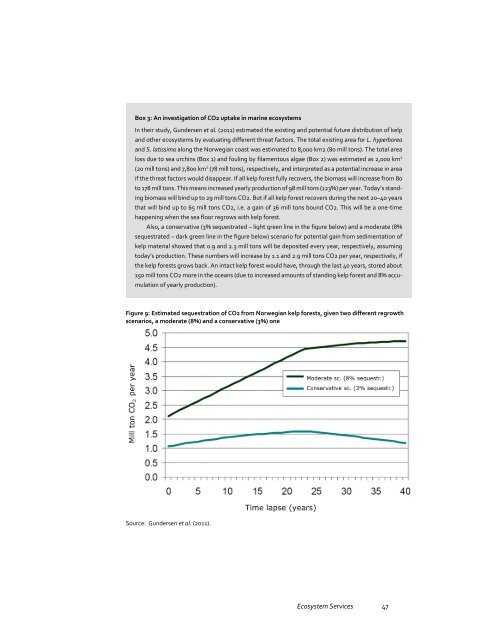Ecosystem Services
FULLTEXT01
FULLTEXT01
You also want an ePaper? Increase the reach of your titles
YUMPU automatically turns print PDFs into web optimized ePapers that Google loves.
Box 3: An investigation of CO2 uptake in marine ecosystems<br />
In their study, Gundersen et al. (2011) estimated the existing and potential future distribution of kelp<br />
and other ecosystems by evaluating different threat factors. The total existing area for L. hyperborea<br />
and S. latissima along the Norwegian coast was estimated to 8,000 km2 (80 mill tons). The total area<br />
loss due to sea urchins (Box 1) and fouling by filamentous algae (Box 2) was estimated as 2,000 km 2<br />
(20 mill tons) and 7,800 km 2 (78 mill tons), respectively, and interpreted as a potential increase in area<br />
if the threat factors would disappear. If all kelp forest fully recovers, the biomass will increase from 80<br />
to 178 mill tons. This means increased yearly production of 98 mill tons (123%) per year. Today’s standing<br />
biomass will bind up to 29 mill tons CO2. But if all kelp forest recovers during the next 20–40 years<br />
that will bind up to 65 mill tons CO2, i.e. a gain of 36 mill tons bound CO2. This will be a one-time<br />
happening when the sea floor regrows with kelp forest.<br />
Also, a conservative (3% sequestrated – light green line in the figure below) and a moderate (8%<br />
sequestrated – dark green line in the figure below) scenario for potential gain from sedimentation of<br />
kelp material showed that 0.9 and 2.3 mill tons will be deposited every year, respectively, assuming<br />
today’s production. These numbers will increase by 1.1 and 2.9 mill tons CO2 per year, respectively, if<br />
the kelp forests grows back. An intact kelp forest would have, through the last 40 years, stored about<br />
150 mill tons CO2 more in the oceans (due to increased amounts of standing kelp forest and 8% accumulation<br />
of yearly production).<br />
Figure 9: Estimated sequestration of CO2 from Norwegian kelp forests, given two different regrowth<br />
scenarios, a moderate (8%) and a conservative (3%) one<br />
Source: Gundersen et al. (2011).<br />
<strong>Ecosystem</strong> <strong>Services</strong> 47


